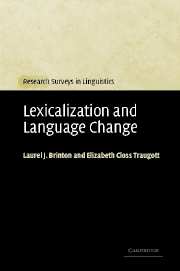Book contents
- Frontmatter
- Contents
- List of figures
- List of tables
- Preface
- List of abbreviations
- 1 Theoretical contexts for the study of lexicalization and grammaticalization
- 2 Lexicalization: definitions and viewpoints
- 3 Views on the relation of lexicalization to grammaticalization
- 4 Toward an integrated approach to lexicalization and grammaticalization
- 5 Case studies
- 6 Conclusion and research questions
- References
- Index of names
- Index of subjects
- Index of words and forms
3 - Views on the relation of lexicalization to grammaticalization
Published online by Cambridge University Press: 03 February 2010
- Frontmatter
- Contents
- List of figures
- List of tables
- Preface
- List of abbreviations
- 1 Theoretical contexts for the study of lexicalization and grammaticalization
- 2 Lexicalization: definitions and viewpoints
- 3 Views on the relation of lexicalization to grammaticalization
- 4 Toward an integrated approach to lexicalization and grammaticalization
- 5 Case studies
- 6 Conclusion and research questions
- References
- Index of names
- Index of subjects
- Index of words and forms
Summary
Introduction
Lexicalization is often discussed in isolation from grammaticalization, especially in studies of word formation. However, it has increasingly been the case that it has entered into grammaticalization studies. One area in which the linking of lexicalization and grammaticalization is especially apparent is in work on fusion, including what has been called freezing, univerbation, or bonding, depending on the type of item that undergoes boundary loss. Fusion of syntagmatically free items into fixed phrases and sometimes further reduction by coalescence is typical both of certain types of lexicalization (cf. gate-crasher, blackbird [pronounced with syllabic r]) and of grammaticalization (cf. Eng. within, Fr. chanterai). For this reason, the same data are sometimes argued to be instances of lexicalization or grammaticalization or both. A few examples are discussed in Section 3.1. When fusion is conceptualized in the larger context of discussions of unidirectionality – a theoretical construct that has emerged most prominently in work on grammaticalization – parallels between lexicalization and grammaticalization readily emerge (3.2). These parallels concern loss of compositionality, both fusion of originally separable morphemes on the dimension of form and idiomaticization on the dimension of meaning; many examples have been cited in Chapter 2. Unidirectionality encompasses other changes in the grammaticalization literature as well, most especially “less to more grammatical” status of form–meaning pairs. Where changes have been identified that do not conform to unidirectionality, they are often considered to be lexicalizations that are the opposite, reverse, or “mirror images” of grammaticalization (see 3.3), and hence a kind of degrammaticalization (3.3.1).
- Type
- Chapter
- Information
- Lexicalization and Language Change , pp. 62 - 88Publisher: Cambridge University PressPrint publication year: 2005



